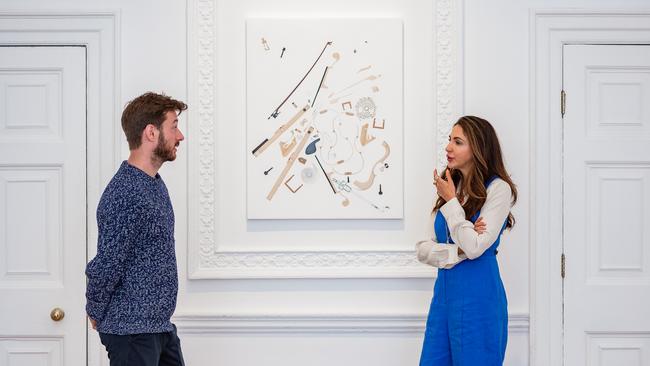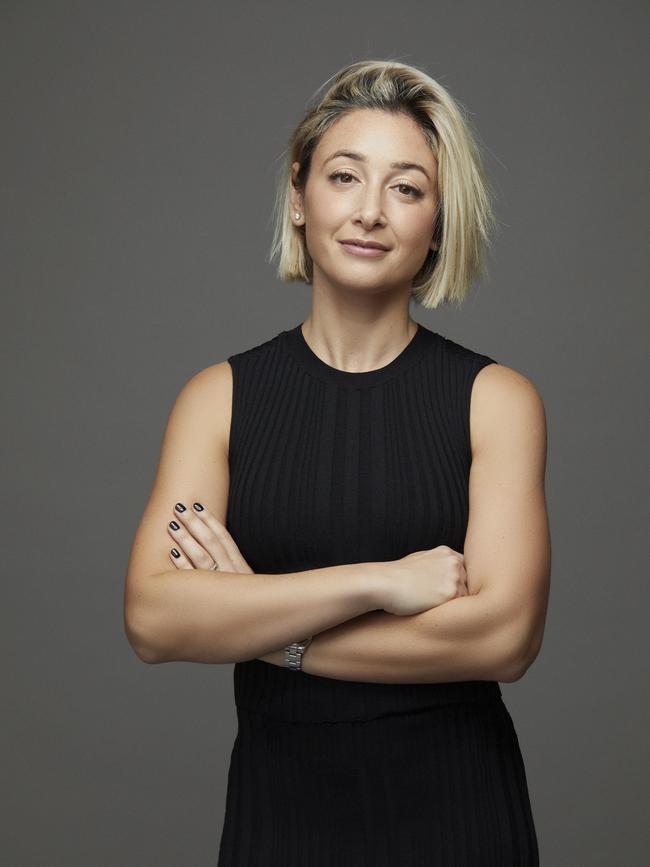From dealers to choosing the perfect piece: how to start collecting art for beginners
Art curator and founder of the Guest Club Alana Kushnir shares her tips to building a meaningful art collection from scratch.

If you don’t live and breathe it, the art market can feel like an intimidating beast to approach. Films have been made about the scene’s notoriety and exclusivity (2019’s Velvet Buzzsaw, 2013’s The Best Offer) and exorbitant auction figures – like the recent record-breaking Brett Whiteley work – often make international news headlines.
It’s a wonder, then, that more platforms like Melbourne-based Guest Club don’t exist. Launched in late 2019 by arts lawyer and curator Alana Kushnir, Guest Club’s aim is to inform and connect prospective buyers with galleries and artists both locally and globally through meet-and-greet events, VIP walk-throughs of art fairs (both virtual and IRL) and ‘master classes’, whereby Kushnir or a guest curator takes members through the A-Z of a certain topic. A collector herself, Kushnir knows the ins and outs of the art market better than most, and advising Guest Club members on how to build their collections makes up a big part of what she does.
Recently, we sat down with the Australian curator and Principal Investigator of the Serpentine Galleries R & D Platform Legal Lab in London, to hear what she considers a ‘good buy’ and why.
Art is more than a wall-filler
“I often hear people say: ‘I have this wall in my house, and I’m looking for an artwork to go there’,” says Kushnir. It sounds like a logical enough starting point – of course you want something that’s going to compliment whatever vibe you’re cultivating at home. But according to Kushnir, this approach can be limiting – what happens when you decide to redecorate, or you move house (which Australians do often – according to the most recent census almost half of us have uprooted at least once in the last five years) and the piece doesn’t fit?
“I totally get it,” says the curator, of wanting to buy a piece to fill a space. “But to me, that’s untapped potential. There’s so much more you can get from owning an artwork and living with an artwork that goes beyond that purely aesthetic factor.”
Kushnir advises her clients to purchase pieces based on the connection they feel with the work, or the artist. This way, even if you don’t have room to hang the work (she confesses she owns many piece she doesn’t currently have a plot on the wall for), your connection to it transcends the material. “At the end of the day, you want something you’ll feel connected to long term, that you can live with long term.”
Think of it as buying a pet. You don’t bring home a golden retriever because he looks cute in the sun-drenched corner of your living room. You buy him with the intention of loving him and having him for a very long time. Art should be approached similarly.
“If you want to own the piece for 20, 30 or 50 years, it has to do more than just ‘look good’,” confirms Kushnir.

What you ‘connect’ with vs. what you think you should buy
This brings us to a valid question: if you’re only just embarking on your art collection journey, how are you supposed to know when you’ve truly ‘connected’ with an artist or artwork?
This is where advisers like Kushnir come in. While not everyone has the ability (or confidence) to walk into a commercial gallery and spend time getting to know the works, Kushnir’s intention is that The Guest Club will provide prospective buyers with the knowledge, opportunities and connections needed to foster an understanding of what’s a good buy for them.
“I wanted to pair artists with collectors in such a way that both parties could feel like they were engaging more fulfilling purchases,” explains the curator. She says a connection could be as simple as admiring an artists work from afar, then meeting them in person and feeling a sense of synergy. Or maybe you’ve been able to spend time with an artist, and – like Kushnir did with her first purchase – you want a memento of that. The Guest Club founder says that increasingly, connections between buyers and artists begin on Instagram. “The younger generation actually like to do their own research. Today it’s so easy to find an artist and reach out to them online. Buyers want to really be involved in building those relationships with artists, and playing an active part in the purchasing decisions.”
Building an art collection around creations you feel connected to might sound little… romantic. But this way, you’re not just surrounding yourself with inanimate objects that someone told you were trendy at the time of purchase. You’re building a stable of memories that’s also an expression of your taste, which, in Kushnir’s opinion, is where the joy of art collecting comes from.
Don’t be too focused on the investment factor
Yes, art can increase in value. But if you’re collecting solely for a return on investment, you could find yourself feeling disappointed and owning a hodgepodge of pieces you have no real connection to.
“When you start out collecting anything, you’ve always got that investment question in the back of your mind,” acknowledges Kushnir. “But art is a gamble, really, and it’s very hard to predict where the market will go.” She says that of course, there are certain cues you can look at to see how valuable a certain artist’s work might be – things like where an artist has exhibited before and what institutions around the world collect their pieces. But Kushnir is of the belief that there’s more to art collecting than money, and to rely on your acquisitions making you money can leave you feeling empty.
“Investment is one of many pieces to the collecting puzzle, and I certainly take into consideration how a piece will hold its value over time,” says the founder. “My sense, though, is that the priority for younger collectors especially is finding pieces they want to live with; pieces that will become part of their lives.”
A diverse collection is a good collection
“I’m definitely a supporter of having a good balance when you’re buying art,” says Kushnir, “I try to steer clear telling people to buy just local, or just international art – unless they really feel strongly about it,” she adds. “But I prefer to focus on the artist rather than putting them in a specific box, and then collecting just on that basis.”
She says there are some collectors out there who do focus on specific mediums, eras or styles – the actor Steve Martin (yes, he of Pink Panther fame) has an extensive collection of Indigenous Australian art, for example. But Martin and his wife Anne Stringfield are seasoned collectors. When you’re just starting out, Kushnir says it pays to keep an open mind. Then you might find yourself gravitating towards something more specific some years’ down the track as your understanding of art matures.
When it comes to art market trends, or “waves” as Kushnir calls them (“the art world is very trend-averse”), she recommends paying attention to them but not confining yourself to them. This year, for example, has seen a huge explosion of interest in art by Black and Indigenous creators, something Kushnir says there’s a huge need for, “because there’s been such an imbalance of voices in the industry, leading up to today.” But she’s reticent to encourage buyers to purchase Indigenous art for the sake of purchasing Indigenous art – that would be performative, after all.
“I think you’re selling the opportunity short,” she says. “I’m not a fan of tokenism and there’s a lot of tokenism out there today. But at the end of the day, that gets back to owning something for the sake of owning something. And artists deserve more than that.”
Start broad, choose pieces you connect with and don’t be too preoccupied with money or trends. Because then, you’ll end up with a family of artworks you love, and any increase in value (or perfect wall-to-artwork ratios) will manifest like cherries on top.

